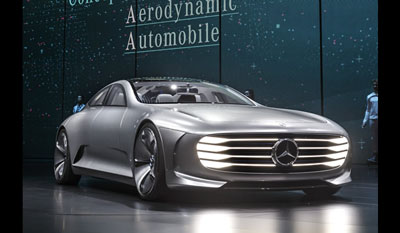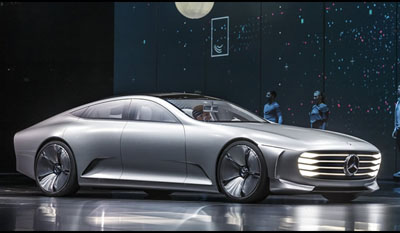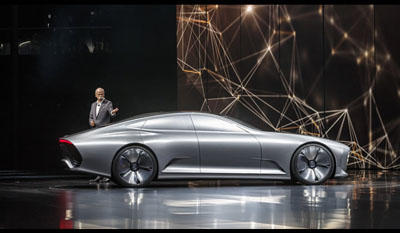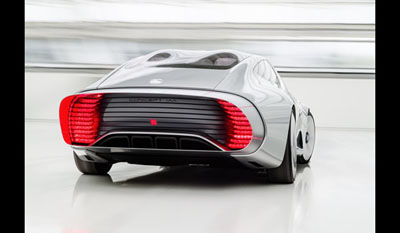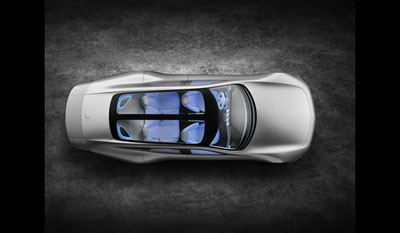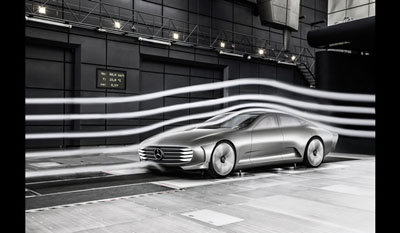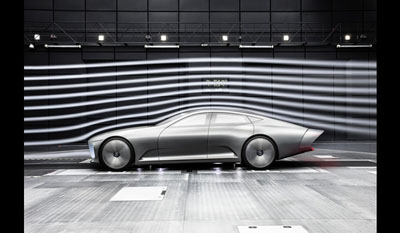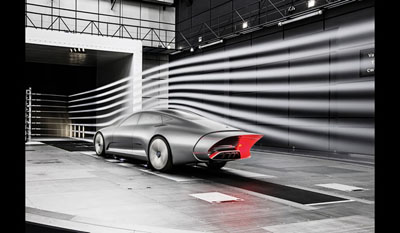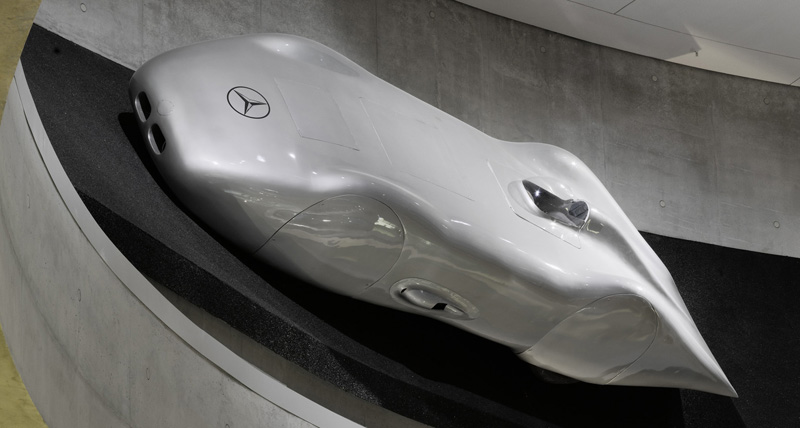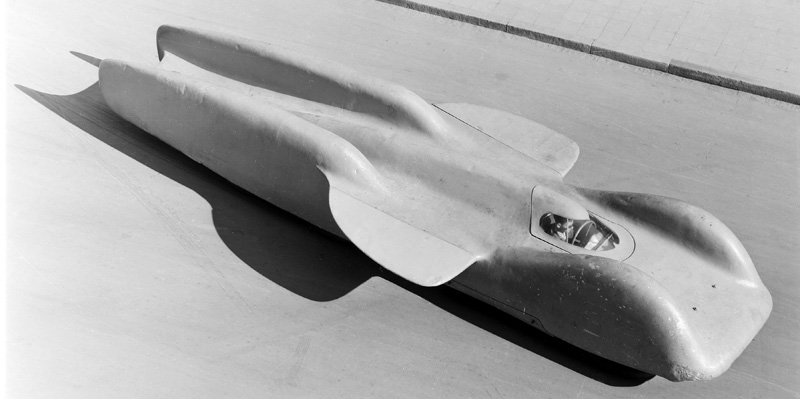Mercedes-Benz "Concept IAA" 2015
Concept IAA : Intelligent Aerodynamic Automobile : Digital transformerThe Mercedes-Benz "Concept IAA" (Intelligent Aerodynamic Automobile) is two cars in one: an aerodynamics world champion with a Cd value of 0.19 and a four-door coupé embodying irresistible design. The study, which is celebrating its world premiere at the Frankfurt International Motor Show, switches automatically from design mode to aerodynamic mode when the vehicle reaches a speed of 80 km/h, whereby numerous aerodynamics measures alter the shape of the vehicle. Inside, the "Concept IAA" continues the design line of the S-Class and S-Class Coupé, offers new touch-based functions and provides an idea of what the interior of a business saloon might look like in the near future. At the touch of a button, or automatically on reaching a speed of 80 km/h, the Mercedes-Benz "Concept IAA" (Intelligent Aerodynamic Automobile) performs a fascinating transformation in which the captivatingly beautiful four-door coupé turns into an aerodynamics world champion: eight segments extend at the rear, increasing its length by up to 390 millimetres; front flaps in the front bumper extend by 25 mm to the front and 20 mm to the rear, improving the air flow around the front end and the front wheel arches; the Active Rims alter their cupping from 55 mm to zero; and the louvre in the front bumper moves 60 mm to the rear, improving the underbody air flow. "Fascinating and technically sophisticated cars form the core of Mercedes-Benz. The 'Concept IAA' applies intelligent innovations to resolve the conflicting aims of functionality and aesthetics and shows that we still have plenty of ideas on how to achieve further improvements in efficiency," says Prof. Dr Thomas Weber, Member of the Daimler Board of Management responsible for Group Research and Head of Mercedes-Benz Cars Development. Equally, the "Concept IAA" exemplifies the fundamental technological changes which are taking place in the automobile industry. The primary driving force behind this process of change is digitisation – commonly referred to in a business context as "Industry 4.0". For Mercedes-Benz, a continuous digital process chain from research and development through production to marketing and sales, logistics and the service area is already becoming reality. The design and aerodynamic shaping of the "Concept IAA" would not have been possible without the systematic digital networking of different specialist departments. The designers have employed the latest algorithmic design methods to handle the complex geometric design. The individually adapted software enables dynamic design in three-dimensional space. This dynamic modelling makes it possible to display and model different states simultaneously. The resultant highly complex geometries were turned into reality with the aid of innovative production technologies (rapid prototyping). The world-beating aerodynamics were developed in parallel with the aid of numeric flow simulation. In around one million CPU hours, the aerodynamics experts from Mercedes-Benz simulated the flow characteristics, calculating some 300 variants. This roughly corresponds to the scope of work involved in developing a production model. Exterior design: sensual purity and innovative aerodynamicsWith its dynamic basic shape ("drop shape"), elegantly purist overall design and aerodynamic innovations, the four-door "Concept IAA" Coupé Saloon is a symbiosis of design and aerodynamics. The vehicle interprets classic sports car proportions in a modern vein: the long bonnet flows aerodynamically into the compact, set-back greenhouse, whose roof slopes down elegantly towards the rear, ending in an airflow break-away edge. "The 'Concept IAA' continues our series of visionary concept cars," explains Gorden Wagener, Head of Design at Daimler AG. "The symbiosis of alluring forms showcasing intelligent aerodynamics is an expression of our unique Mercedes-Benz design philosophy."
The interior: touch-based operating philosophyThe interior of the "Concept IAA" combines stylish sportiness with modern luxury. The interior continues the design line of the S-Class and S-Class Coupé while providing an idea of what the interior of a business saloon might look like in the near future. The choice of colours and materials conjures up extrovert contrasts between anthracite and white as well as between aluminium and cut glass. Elegantly curved forms, flowing lines, carefully chosen high-quality materials and the touch-based operating philosophy provide for a high level of functionality. Aerodynamics: New Cd world record achieved through active transformationTwo cars in one – on reaching a speed of 80 km/h, the "Concept IAA" switches automatically from design mode to aerodynamic mode, whereupon numerous active aerodynamic measures alter its appearance. As a result of this transformation, the Cd value improves from 0.25 to 0.19 – a new world record for a four-door four-seater. The frontal area totals 2.16 m2.
As a result of the streamlined design, the downward slope of the roof line begins further towards the front. In order to offer the rear passengers sufficient headroom, the roof thus incorporates two rises over the rear seats. The "Concept IAA" aerodynamics world champion was initially evolved with the aid of numeric flow simulation. In around one million CPU hours, the aerodynamics experts from Mercedes-Benz simulated the flow characteristics, calculating some 300 variants. This roughly corresponds to the scope of work involved in developing a production model. Fine tuning then took place in the wind tunnel in Sindelfingen – another parallel with series production development. Wallpapers of the Mercedes-Benz "Concept IAA" 2015
The heritage: Aerodynamically perfected record-breaking carsThe "Concept IAA" forms part of a long line of aerodynamically perfected passenger cars, racing cars and record-breaking vehicles from Mercedes-Benz, which began in 1909 and achieved a spectacular milestone in the Olympics year of 1936. With a dimensional concept that makes it suitable for everyday use, this four-seater attains a Cd value of 0.19, assuring it of a place in the gallery of record-breaking and racing vehicles described below - although the other cited examples were able to exploit substantially more extreme dimensional concepts without any consideration for spaciousness and comfort. The Mercedes-Benz W 25 record-breaking car of the 1936 season featured a chassis bearing a fully streamlined body for the first time which also included the wheels and the underside of the car. In the wind tunnel at the Zeppelin plant in Friedrichshafen, the experts analysed the body's air flow characteristics and optimised its aerodynamics. These efforts yielded a Cd value of 0.235, a world speed record and three international class records. Rudolf Caracciola clocked up a top speed of 372.1 km/h in the 419 kW (570 hp) record-breaking car. On 28 January 1938, the following project, the Mercedes-Benz W 125 record-breaking car ( picture below ) , set a new speed record on public roads which stands right up to the present day,with Rudolf Caracciolahaving reached a
speed of 432.7 km/h. The record-breaking version of the W 125 Silver Arrow was primed for its special purpose in the wind tunnel of the German test facility for aviation applications in Berlin-Adlershof. The flat, fully panelled body with a wedge-shaped rear end achieved a sensational Cd value of 0.157. A radically scaled-down air intake at the front was a further contributory factor here. This meant that the record-breaking car only breathed in the amount of air that the 5.6-litre V12 engine with an output of 541 kW (736 hp) required in order to operate. The engine cooling system did not use fresh air at all. Instead, the radiator was encased in a box filled with 500 litres of ice and water, which at the same time reduced lift at the front axle. The 8.24 metre-long T 80 three-axle record-breaking vehicle from 1939 ( picture below )was an even more radical proposition. With this car, Mercedes-Benz aimed to break the world speed record which had been pushed up to 595 km/h on a salt lake in Utah, USA in 1939. The powerful vehicle was to be driven by an 807-kilogram V12 aircraft engine generating a massive 2574 kW (3500 hp) of power from a displacement of 44.5 litres. The T 80 was never deployed, however, due to the outbreak of the Second World War.
For the motorway: 540 K Streamliner from 1938The acquired aerodynamic findings were applied not only for record-breaking attempts, however, but also on the road. The Mercedes-Benz 540 K Streamliner built in 1938 crowned the development of aerodynamically optimised Mercedes-Benz vehicles in the 1930s. The one-off model based on the Stuttgart-based brand's sporty top-of-the-range model set both technical and aesthetic standards. In the light of ever-faster travelling speeds made possible by the swift pace of technological progress and the growing network of fast roads, the aerodynamics of powerful passenger cars acquired increasing importance with regard to efficiency aspects in particular. With the flowing lines and the low profile of its aluminium body, the minimised drag sources on its surfaces and the panelled underbody, the Streamliner applied the findings of research in exemplary manner – with a remarkably low drag coefficient of Cd = 0.36. Full Review of the 540 K Streamliner from - here
Mercedes-Benz 2.5-litre streamlined racing car W 196 R, 1954The streamlined design of the Silver Arrows became a global talking point once again in 1954 with the arrival of the totally new W 196 R racing car. The aerodynamically optimised streamlined version, which was still allowed in Formula 1 at the time, was the first to be built for the 1954, because the opening race in Reims/France permitted very high speeds. A second variant with open wheels followed four weeks later. Mercedes-Benz's return to motor racing ended in spectacular style, with Juan Manuel Fangio and Karl Kling achieving a one-two win. In the improved version of the streamlined car he also won the last race in which the W 196 R competed - the 1955 Italian Grand Prix. This sealed Fangio's second world championship title driving the Silver Arrows. Full Review of the Mercedes-Benz 2.5-litre streamlined racing car W 196 R, 1954 - here
Mercedes-Benz C 111-III record-breaking car, 1978From 1969 on, Mercedes-Benz built a series of experimental and record-breaking vehicles with the internal designation C 111. The C 111-III diesel record-breaking car from 1978 underwent systematic aerodynamic optimisation. The vehicle was slimmer than its predecessor, with a longer wheelbase, fully faired wheels and a long rear end. This design lowered the Cd value of the C 111 to 0.183. On record-breaking runs at the high-speed circuit in Nardò in southern Italy, the vehicle provided an impressive demonstration of efficiency, with a five-cylinder in-line turbodiesel engine rated at 169 kW (230 hp) powering the streamlined car to speeds well beyond 300 km/h. The nine world records achieved with the C 111-III include an average speed of 319 km/h over a distance of 1000 miles (1609 km). Full Review of the Mercedes-Benz C 111-III record-breaking car, 1978 - here
|
||||||||||||||||||||||||||||||||||||||
|---|---|---|---|---|---|---|---|---|---|---|---|---|---|---|---|---|---|---|---|---|---|---|---|---|---|---|---|---|---|---|---|---|---|---|---|---|---|---|
|
||||||||||||||








